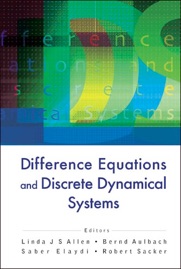Invariant manifolds
AAU
Dissipative delay endomorphisms and
Advanced Studies in Pure Mathematics 53, 2009, 237-259
Using an invariant manifold theorem we demonstrate that the dynamics of nonautonomous dissipative delayed difference equations (with delay M) is asymptotically equivalent to the long-term behavior of an N-dimensional first order difference equation with (N≤M) - assumed the nonlinearity is small Lipschitzian on the absorbing set. As consequence we obtain a result of Kirchgraber [Multi-step methods are essentially one-step methods, Numerische Mathematik 48, 85-90, 1986] that multi-step methods for the numerical solution of ordinary differential equations are essentially one-step methods, and generalize it to varying step-sizes.
Taylor approximation of integral manifolds
(with M. Rasmussen) Journal of Differential Equations and
Dynamical Systems 18(2), 2006, 427-460
Integral manifolds generalize invariant manifolds to nonautonomous ordinary differential equation. In this paper, we develop a method to calculate their Taylor approximation with respect to the state space variables. This is of decisive importance, e.g., in nonautonomous bifurcation theory or for an application of the reduction principle in a time-dependent setting.
Local approximation invariant fiber bundles:
An algorithmic approach
(with M. Rasmussen), in Difference Equations and Discrete Dynamical Systems, L.J.S. Allen, B. Aulbach, S. Elaydi, R.J. Sacker, eds., World Scientific, New Jersey, 2005, 155-170
This paper contains an approach to compute Taylor approximations of invariant manifolds associated with arbitrary fixed reference solutions of nonautonomous difference equations. Our framework is sufficiently general to include, e.g., stable and unstable manifolds of periodic orbits, or classical center-stable/-unstable manifolds corresponding to equilibria. In addition, our focus is to give applicable and quantitative results.
Finally, in the appendix we present a short manual to the Maple program IFB_Comp to calculate Taylor approximations of invariant manifolds.
Taylor approximation of invariant fiber bundles for nonautonomous difference equations
(with M. Rasmussen) Nonlinear Analysis (TMA) 60(7), 2005,
1303-1330
Invariant fiber bundles generalize invariant manifolds to nonautonomous difference equations. In this paper, we develop a method to calculate their Taylor approximation, which is of crucial importance, e.g., for an application of the reduction principle in a nonautonomous setting.
Cm-smoothness of invariant fiber bundles
(with S. Siegmund) Topological Methods in Nonlinear Analysis 24(1), 2004, 107-146
The method of invariant manifolds, now called the “Hadamard-Perron-Theorem”, was originally developed by Lyapunov, Hadamard and Perron for time-independent maps and differential equations at a hyperbolic fixed point. It was then extended from hyperbolic to non-hyperbolic systems, from time-independent and finite-dimensional to time-dependent and infinite-dimensional equations. The generalization of an invariant manifold for a discrete dynamical system (mapping) to a time-variant difference equation is called an invariant fiber bundle. While in the hyperbolic case the smoothness of the invariant fiber bundles is easily obtained with the contraction principle, in the non-hyperbolic situation the smoothness depends on a spectral gap condition, is subtle to prove and proofs were given under various assumptions by basically three different approaches, so far: (1) A lemma of Henry, (2) the fiber-contraction theorem, or (3) fixed point theorems for scales of embedded Banach spaces.
In this paper we present a new self-contained and basic proof of the smoothness of invariant fiber bundles which relies only on Banach’s fixed point theorem. Our result extends previous versions of the “Hadamard-Perron-Theorem” and generalizes it to the time-dependent, not necessarily hyperbolic, infinite-dimensional, non-invertible and parameter-dependent case. Moreover, we show by an example that our gap-condition is sharp.
Stability of center fiber bundles for nonautonomous difference equations
in Difference and Differential Equations, S. Elaydi, G. Ladas, J.
Wu, X. Zou, eds., Fields Institute Communications 42, AMS,
Providence RI, 2004, 295-304
Center fiber bundles are the generalization of center manifolds to nonautonomous difference equations. Following closely an idea of Palmer, we deduce the essential stability properties of such fiber bundles, namely their asymptotic phase and a reduction principle.
Invariant manifolds with asymptotic phase for
nonautonomous difference equations
(with B. Aulbach) Journal of Computers and Mathematics with
Applications 45, 2003, 1385-1398
For autonomous difference equations with an invariant manifold conditions are known which guarantee that a solution approaching this manifold eventually behaves like a solution on the manifold. In this paper, we extend the fundamental result in this context to difference equations which are nonautonomous and whose solutions are guaranteed only in forward time.
A smoothness theorem for invariant fiber bundles
(with B. Aulbach and S. Siegmund) Journal of Dynamics and
Differential Equations 14(3), 2002, 519-547
Invariant fiber bundles are the generalization of invariant manifolds from discrete dynamical systems (mappings) to nonautonomous difference equations. In this paper, we present a self-contained proof of their existence and smoothness. Our main result generalizes the so-called “Hadamard-Perron-Theorem“ for time-dependent families of pseudo-hyperbolic mappings from the finite-dimensional invertible to the infinite-dimensional non-invertible case.
Christian Pötzsche (Aug 2021)
Topological decoupling and linearization of nonautonomous evolutionary equations
(with E. Russ) Discrete and Continuous Dynamical Systems (Series S) 9(4), 2016, 1235-1268
Topological linearization results typically require solution flows rather than merely semiflows. An exception occurs when the linearization fulfills spectral assumptions met e.g. for scalar reaction-diffusion equations. We employ tools from the geometric theory of nonautonomous dynamical systems in order to extend earlier work by Lu to time-variant evolution equations under corresponding conditions on the Sacker-Sell spectrum of the linear part. Our abstract results are applied to nonautonomous reaction-diffusion and convection equations.
(with E. Russ) Nonautonomous Dynamical Systems 8, 2021, 46-74
The purpose of this informal paper is three-fold: First, filling a gap in the literature, we provide a (necessary and sufficient) principle of linearized stability for nonautonomous difference equations in Banach spaces based on the dichotomy spectrum. Second, complementing the above, we survey and excemplify an ambient nonautonomous and infinite-dimensional center manifold reduction, that is, Pliss’s reduction principle suitable for critical stability situations. Third, these results are applied to integrodifference equations of Hammerstein- and Urysohn-type both in C- and L^p-spaces. Specific features of the nonautonomous case are underlined. Yet, for the simpler situation of periodic time-dependence even explicit computations are feasible.









